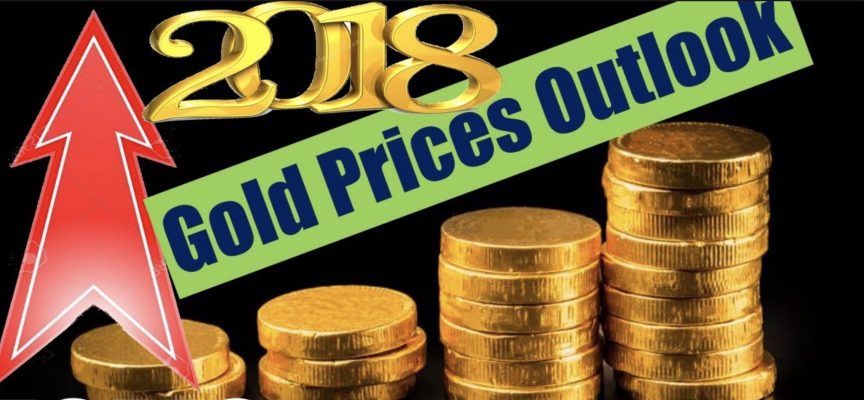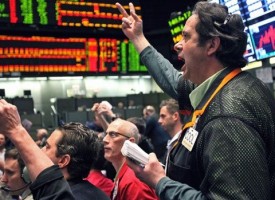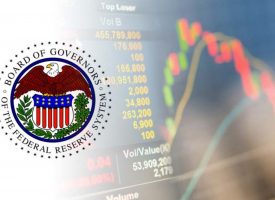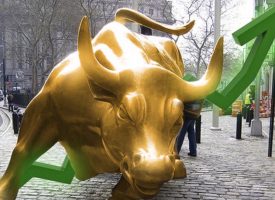As we continue early trading in what has been a wild start to the new year, today a legend in the business sent King World News a powerful piece warning that the price of gold is set to soar nearly $1,000.
Gold’s Price Set To Soar
By John Ing, Maison Placements
January 18 (King World News) – America itself has become the largest bubble in economic history. The progression of bubbles from equities, to corporate credit, classic cars, Da Vincis to bitcoin, have expanded in scope and risk becoming an insidious process. Today, almost every asset class is up thanks to our central banks, led by the Fed, printing enormous amounts of new money such that their combined balance sheets topped $20 trillion or one third of the world’s GDP, after purchasing their respective government debt in massive amounts. Now, a second massive injection of liquidity is to hit the markets with the largest tax overhaul in the United States expected to boost the economy and further extend the market’s winning bull run. Dow 50,000? Possible, since we believe the stock market no longer is a discounting mechanism but a manifestation of the world’s biggest bubble. Keynes would be proud.
Consumer confidence is at 17-year highs, unemployment at 4.1 percent, a 17-year low. Oil soared to 4-year highs. Surprisingly, the US stock market’s performance is overshadowed by bitcoin mania, surpassing the Dutch tulip bubble, dot.com bubble and even the tech bubble. Greed has pushed valuations even higher. Of concern is that while the ultra loose policies have finally boosted activity, the revival has awakened long-dormant inflationary pressures.
 Debt, Debt and More Debt
Debt, Debt and More Debt
After almost a decade of low interest rates, a borrowing binge pushed debt and asset prices to record levels. This voracious appetite for debt lies at the heart of this boom which will end in a bust. Governments are now a larger share of the economy, thanks to an increase in public borrowings. US government debt alone is the world’s largest at $14.5 trillion. As a result, most central banks serve as major creditors to their respective governments, posing a problem particularly when rates turn-up, creating a spate of losses and sovereign debt crises. The low interest rates also forced investors to chase returns on riskier credits. Markets have become addicted to low rates and like any addiction, needs lower and lower rates in higher doses. Although blue-chip companies such as Microsoft and Apple have balance sheets choking with cash, they raised even more debt taking advantage of the ultra-low rates. Corporations added a whopping $1.4 trillion of debt last year.
But now, US treasury yields are at their highest since March amid central banks’ promises to tighten. Yet complacent investors have ignored the threat believing that the minuscule rate increases last year and asset sales would be offset by the Republican tax cut. And under departing Fed Chair Yellen’s promise to “normalize “, the Fed’s balance sheet still stands at $4.4 trillion after a $6 billion or 0.14 percent reduction. Normalization it seems will take at least a decade at this rate…
IMPORTANT:
To hear which legend just spoke with KWN about $8,000 gold and the coming mania in the
gold, silver, and mining shares markets CLICK HERE OR ON THE IMAGE BELOW.
 Sponsored
Sponsored
Having pursued monetary laxity, governments saw their debt loads soar to the point that the debt in bubble-prone United States has grown from $10 trillion to $20 trillion in less than a decade such that today their debt to GDP is over 100 percent (before
entitlements). Put another way, US debt is equal to its entire annual economic output, worse than many Latin American or European countries. Instead of needed cuts in spending and entitlements, the Republicans instead chose sweeping tax cuts, and financing the revenue shortfall by adding more debt, a recipe for disaster as they try to print their way to prosperity.
And tellingly, the US dollar suffered its worst annual performance in 14 years declining by some 12 percent and in fact is lower than when Trump was elected. Trump’s recent musings raised fears of a “stealth” currency war, angering and unnerving allies, pushing the greenback lower. A lower dollar however will help boost the US economy but also revive the inflationary fires because no one yet has taken the punch bowl away.
 Inflation is Back
Inflation is Back
While the US stock market rose almost 20 percent last year, Europe did even better, with a 27 percent gain on hopes for a continuation of the global boom. While no doubt there is a need for a short-term market correction, we believe that markets will continue to ignore the systemic risk imbalances and excesses caused by the greatest bubble ever. The bubbles will get even larger. Commodities are at three-year highs as investors pour money into everything from oil to copper. Gold topped $1,300 an ounce just when the central banks gave up on inflation. History shows that a resurgence in inflation follows a series of bubbles. Like the seventies, we are at the beginning of the inflationary cycle.
America has fallen further behind their economic rivals, particularly in the Far East because they emphasized consumption rather than investment. Looming trade disputes with Japan, China, South Korea and even Canada will test Trump’s “America First” policy, made worse if there is a government shutdown.
And just when inflation is declared dead by our central bankers, we believe inflation is back. A leading indicator, commodities are at three-year highs as both hurricanes and now cold weather roil the commodity markets, not too dissimilar when the anchovies went missing off the coast of Peru which helped push inflation to double digit levels in the seventies. Energy is at four-year highs on Middle East woes and the ultimate indicator, the stock market, posts yet another all-time high.
 Who Will Pay the Piper?
Who Will Pay the Piper?
America’s consumption binge is the root of the problem and the alchemy of debt-financed deficits allows them to spend their way to prosperity. Simply America’s economic expansion was a giant experiment in the reliance on credit. Yet like others before that have tried to do so in the past, the US thinks it is different this time.
American consumers’ voracious appetite to keep spending for homes to cars to bigger flat screen TVs allow its trading partners to sell them goods and services in undervalued currencies. Money flowed into the United States. This recycling arrangement worked for some time but the flow of funds recently shifted when America introduced negative interest such that foreigners became reluctant to subsidize dollar-denominated assets. China’s vast $3.3 trillion of reserves has already shrunk by one trillion dollars from their peak. And with lower energy prices, the Middle East players have dumped dollars to fund widening budget deficits. America’s vulnerability is the linkage between its deficits and the rest of the world and noteworthy is that America’s creditors are the same players that are being targeted by Trump as currency manipulators or economic rivals. As such, there is a huge dollar overhang, ripe for a correction. This avalanche of dollars is an accident ready to happen.
A larger danger is that the exponential increase in the budget and tax cuts must be financed because Americans have little savings and are heavily reliant on foreign savings. We remain concerned that foreigners who financed America’s debt clogged financial system will resist holding an ever- increasing share of their wealth in US securities and demand higher rates to pay for America’s bills. Foreign investment in US equities alone, as a percentage of GDP has more than doubled from below 15 percent before the
2008 financial crisis to more than 35 percent today. Recently 10-year US treasuries spiked to their highest level in a year on fears that the central banks of China and Japan might scale back their Treasury purchases.
The keystone to US financial hegemony is the US dollar’s role as the world’s reserve currency, the source of America’s power. It allows America to print money with which to pay its bills, to control the international payments system (SWIFT) and impose sanctions. Nonetheless, America’s creditors have a vote on dollar interest rates, because America consumes much more than it produces and owes abroad much more than it owns. In a currency war, the avalanche of dollars could turn on a dime or a tweet. Two- thirds of the world’s assets are denominated in a debt-based fiat currency, issued by a country whose leaders are seen to be debasing that currency. The central banks of China and Russia have recently diversified their foreign reserves with this in mind, lessening their exposure particularly with America’s penchant to use sanctions to further its goals. Also America from time to time has threatened to block its financial rivals from using the SWIFT clearance system. China recently set up an alternative clearing system, no doubt hedging their bets. The US rejection of Jack Ma’s bid for US based money transfer MoneyGram International is the first of many volleys in the financial war for supremacy.
 Bitcoin’s Popularity
Bitcoin’s Popularity
Kings once had the unalienable privilege of coin issuance. Those who tampered with money were put to the death. Today with a computer, you can print your own tender, make a huge profit, and for some, achieve billionaire status. Certainly, times have changed. It is of no coincidence that the arrival of bitcoin is at the apex of distrust in fiat currencies. In fact, we believe it is the implicit debasement of legal tender today that has given rise to the crypto-makers.
Bitcoin’s volatile rise from zero to $20,000 and then $10,000 belie its role as a store of value. It hinges on cash flow to the owner and the only return is via a rise in price. Unlike gold, equities, bonds or even real estate, it has no intrinsic value. The real risk though is regulatory. To date, the Securities and Exchange Commission (SEC) have resisted the creation of crypto-ETFs notwithstanding that the CBOE and the CME are creating future contracts on bitcoin. In Canada, the OSC too has not approved ETFs, notwithstanding retail demand. We believe that a crack in the dam has already been detected since over-the-counter ETFs trade at a whopping 50 percent premium. Therein lies the crux of the matter. Regulators cannot protect investors from risk; they can only make them disclose. Obviously, there is risk but there would be even more if investors resort to the unregulated shadow markets. It would be better then for regulators to approve cyber- currency ETFs and other type products as long as the risks are disclosed.
Governments also view digital currencies as threats to their fiat currencies and policies. Ironically, we believe that the creation of synthetic ETFs and/or derivatives would allow the hedging of positions which would protect investors from these risks. Those derivatives then would likely prove to be the beginning of the end for crypto-currencies because only then, would there be sellers. To date crypto currencies have experienced buying demand but very little selling, until now.
 Gold Still Rules
Gold Still Rules
There are alternatives. Gold historically was a storm warning for global financial markets. When the seas were calm amid sunny optimism, gold was a non-performer. However, when economic or geopolitical tensions heated up, gold always garnered attention. Noteworthy is that gold has defied interest rate hikes and record market euphoria, rallying to its highest level since 2010, reversing a three-year downtrend. We believe, the jump in gold prices above $1,300 an ounce reflects both fears for the dollar and concerns about the consequences of rising public debt.
Gold was once an effective haven for capital inflows but today the stock market, bonds or even bitcoins serve as surrogate havens. That is to change. On the horizon is a beggar thy neighbor currency war, which America has already launched with the depreciating dollar. Ten years past the collapse of 2008, we believe currency devaluation is to be third and last desperate leg in the central banks’ economic arsenal, joining deficit spending and lax monetary policies. And amid the decline in American influence, geopolitical shifts of tectonic scale have occurred with elections looming in Italy, Germany’s Grand Coalition government and Brexit’s big hit will come from not the exit but the damage to the British economy as it leaves the EU and of course, there are the Middle East uncertainties. China and Russia too have stepped into the vacuum left by America’s newfound isolation taking full advantage of weakness in the West beset by protectionist agendas. Moreover, there is the threat of a trade crackdown. Slapping tariffs on your creditors would trigger a trade war and financial penalties. Gold will be a good thing to have.
In almost half a century, under a fiat system of floating paper currencies, America’s financial position has deteriorated as debt rose causing a series of bubbles followed by busts. Before that, gold was a haven because the amount of credit creation was limited. Governments abandoned the gold standard in the seventies, replacing gold with a fiat currency, the US dollar. The greenback was a suitable replacement as the centre pin in American financial hegemony. However, a decade of man-made flood of dollars to avoid the Great Recession caused such a global glut of capital that cheapened the purchasing power of the dollar. We thus believe that investors will rethink the benefits in seeking refuge in dollar securities or crypto currencies created out of the thinnest of air. Amid the decline in American influence, its rivals are creating an alternate financial global architecture leaving the dollar’s orbit. All this suggest that times are a changing.
FOMO = Fear Of Missing Out!
 Gold is The New Global Currency
Gold is The New Global Currency
Like bitcoin, gold shares the distrust of fiat currencies but, unlike bitcoin, gold is accepted as the medium of exchange by all countries. Gold is an alternative to money, better than bitcoin because it retains intrinsic value. In addition, the total gold supply is limited at 180,000 tonnes while global money proxies are unlimited in size and scope. We believe that the fear of widespread currency debasement will provide the underpinnings for a $2,200 gold price within 18 months, particularly since the Chinese now control the physical gold markets.
Investors continue to ignore the largest bubble in economic history. We believe they would get better returns from gold than the interest bearing securities of the governments who run the printing presses. When the US dollar goes, interest rates will rise, bond prices and the market will collapse. Overvalued US treasuries will then give way to a financial tsunami. Gold is a hedge against the chance that the world’s central banks will prove no better at preventing high inflation than they were stopping another period of stock market exuberance. Gold is the final boat to rise. It is not so different this time…
BONUS INTERVIEW:
To listen to billionaire Eric Sprott discuss his prediction for skyrocketing silver
as well as his top silver pick CLICK HERE OR BELOW:
Conclusion
Gold mining shares have been in a trading range despite a robust third quarter. Still, gold shares have lagged bullion but we believe that the significant underperformance of gold stocks is at an end. Expectations are for the fourth quarter to be much the same but margins have improved as cost cutting has more or less reached its limits. By-product metal prices also helped and some gold miners have begun unveiling exploration programs. Gold too has edged higher on a weaker US dollar.
The gold miners will benefit from a higher gold price, and as gold approaches $1400 an ounce, it will spike higher. Gold technically has to fill a $200 gap and we can see spiking periods ahead which will cause a rush into better leveraged gold shares that have based for three years now.
Also, here is a powerful KWN audio interview with Bill Fleckenstein discussing the gold and silver markets and much more and you can listen to by CLICKING HERE OR ON THE IMAGE BELOW.
***ALSO JUST RELEASED: What Is Happening Is Absolutely Stunning…We Haven’t Seen This In More Than 100 Years CLICK HERE.
© 2018 by King World News®. All Rights Reserved. This material may not be published, broadcast, rewritten, or redistributed. However, linking directly to the articles is permitted and encouraged.









